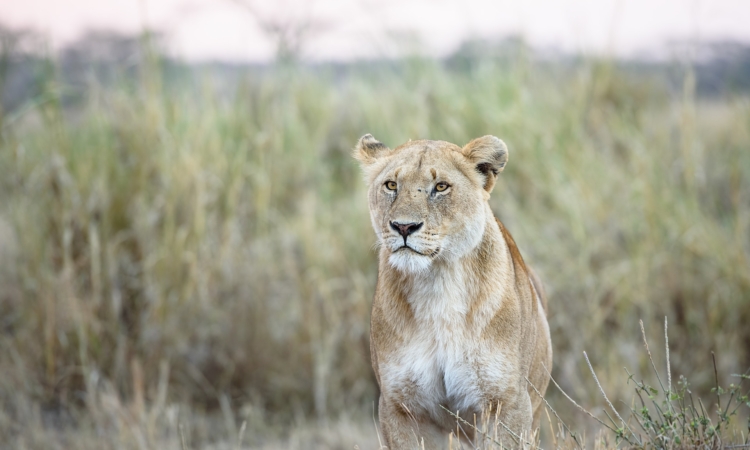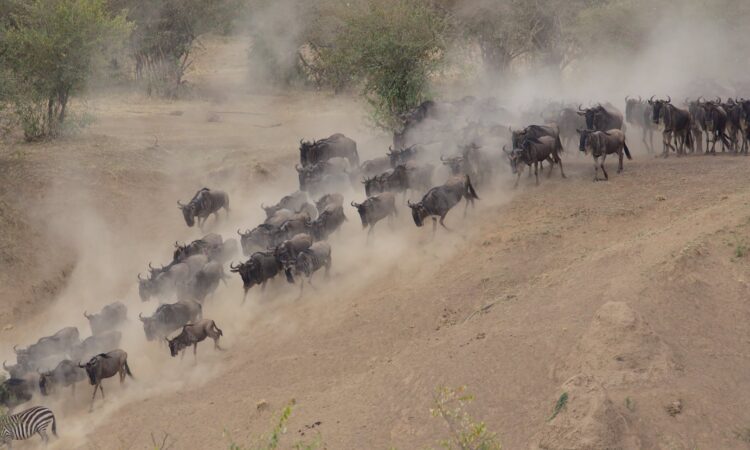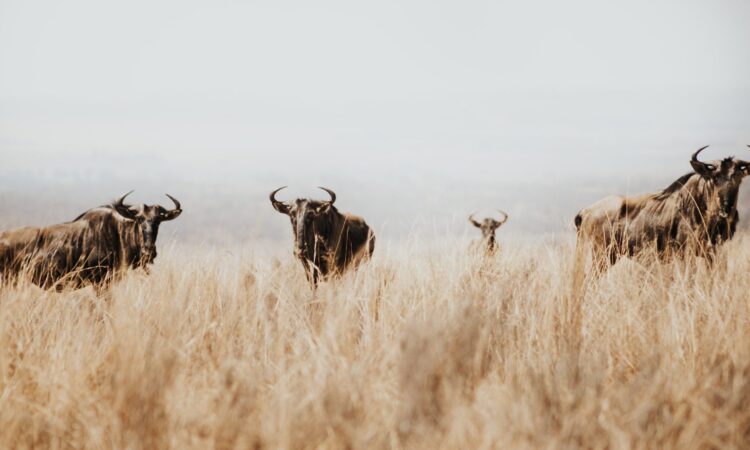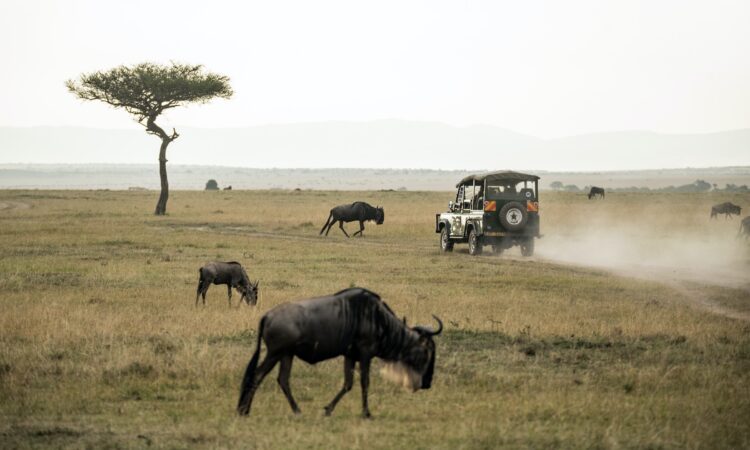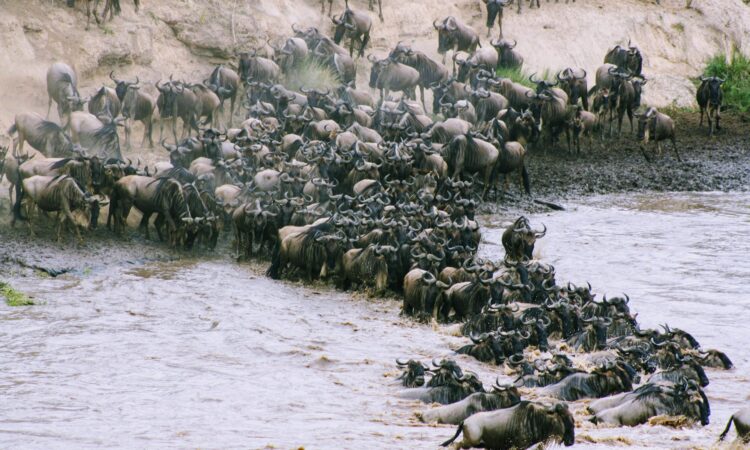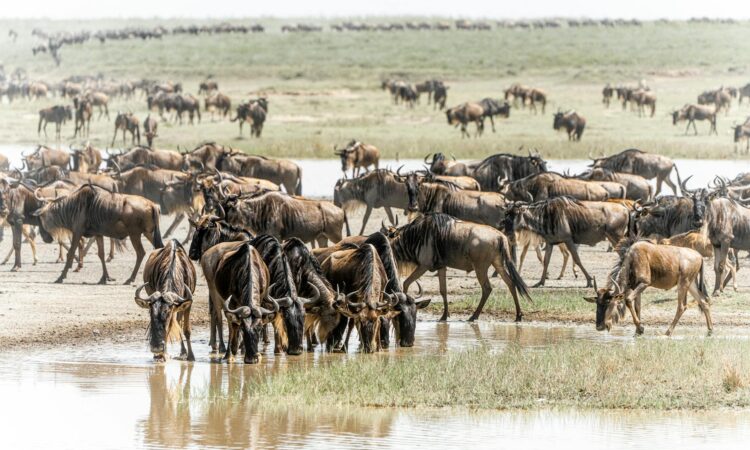This 6-Day Kenya Tanzania Wildebeest Migration Safari to Masai Mara & Serengeti is the best tour you can book.
Top Wildebeest Migration Safari Packages 2025/2026
Check out the most popular wildebeest migration safari tours in Africa as you plan to see the natural wonder in Kenya & Tanzania.
-
 On Offer
On Offer6-Day Kenya Tanzania Wildebeest Migration Safari to Masai Mara & Serengeti
View package -
 On Offer
On Offer10-Day Best of Tanzania Wildebeest Migration Safari, Wildlife, Culture & Leisure
View packageBook this 10-Day Best of Tanzania Wildebeest Migration Safari, Wildlife, Culture & Leisure Tour at affordable costs.
-
 On Offer
On Offer7-Day Best of Wildebeest Migration Safari Packages to Serengeti & Ngorongoro
View packageExplore this 7-Day Best of Wildebeest Migration Safari Packages to Serengeti National Park & Ngorongoro Crater.
-
 On Offer
On Offer4-Day Tanzania Wildebeest Migration Safari to Serengeti National Park
View packageThis 4-Day Tanzania Wildebeest Migration Safari to Serengeti offers a fill migration experience and wildlife viewing.
Explore the Annual Great Wildebeest Migration Occurence in Africa
This annual wildebeest migration is the largest animal migration on earth. The actual reasons why this occurs is wildebeest searching for greener vegetation and water on the other side of the land after when there is drought on the one they are on. When the season is over, they return to the previous side and find vegetation there. They keep taking the same route year in, year out and the predators keep waiting at their exact spots. Discover the great wildebeest migration below.
The great wildebeest migration is one of the wonders of the world that takes place in Masai Mara National Reserve, Kenya, and Serengeti National Park, Tanzania.
This natural occurrence happens every year, and wildebeests consistently follow the same route. The January season is the calving season when millions of wildebeests are born.
These young calves must grow strong enough to make it through the Mara River between June and August, or else they are left behind to die.
Around June, the migration starts, but no one knows what triggers it. This migration continues for several weeks as millions of wildebeests have to migrate.
During this time, many lose their lives, but the few who manage to make it to the other side enjoy the green vegetation and water.
A wildebeest can live up to 40 years old, but many die when still young mainly because of this migration.
How it starts
From January, the last wildebeest crossing to Serengeti NP, Tanzania can be spotted. A huge concentration of them can be watched migrate South from the North-eastern area to Lake Ndutu. From February to March, minimal migration occurs, even around April, May. From June, minimal number of wildebeest can be spotted at Maasai Mara and in Tanzania, they can be arriving at the Grumeti.
In July, the migration river crossing begins in the Maasai Mara and in Tanzania, it will be already taking place in the Northern side, grazing at Seronera and some eastern parts of Serengeti. Around August, the migration takes place daily in Maasai Mara and in Serengeti; you can only experience it in the extreme Northern Serengeti.
September to October, this is regarded as the most ideal time to observe wildebeest in their hundreds or thousands while feeding in Maasai Mara Reserve and in Serengeti, still they will be in the Northern side. From November, they begin migrating back to Serengeti, and most of them will be spotted in the Northern side and few in the central part of Serengeti. In December, majority would have moved back to Serengeti from Maasai Mara making it ideal to go on migration safari in Tanzania, and calving cycling begins again.
Best Migration Dates & Months
While planning your wildebeest migration safari, you should know where to be at certain months. December to April is the best time to see the migration in Serengeti National Park.
During these four months, the wildebeests usually stay put in one place. Most herds are seen between the Ndutu area and Ngorongoro Conservation Area depending on rainfall.
Female wildebeests give birth to over 600,000 calves in a few weeks’ period. If you prefer to see the calves, you should book your safari for this time.
A shocking fact is that wildebeest calves get on their feet 10 minutes after birth and can move. At around June to May when the rainy season is over, the Serengeti plains dry out. This triggers the migration, but no one knows the actual day it begins.
This usually commences in April or May, and a few herds begin their long journey to Masai Mara National Reserve.
At this time, they do not move as a group. Some of the herd members will trek to Grumeti River (a perfect spot in Serengeti to see crocodiles) and the Western Corridor and after proceeding to the north. Some of the wildebeests take a different route.
They trek via the Loliondo area or Seronera area as they proceed to Lobo.
July to November is looked at as the best time to see the great annual wildebeest migration. During this season, the sightings are epic. Between the months of July and August, wildebeests trek into Masai Mara National Reserve in Kenya, crossing the crocodile-infested Mara River in huge numbers. This river crossing is an experience of its kind.
If you’ve always craved to see the great Mara river crossings, this is the best time to plan your safari to witness this wild nature occurrence. During October to November, the wildebeest migration commences to work its way to Serengeti National Park in Tanzania.
There is always a lot of herds to see in the southern region of Maasai Mara National Reserve in Kenya and in Serengeti National Park, North of Tanzania.
The Best Place to See Wildebeest Migration
There is no particular best place for seeing the migration. It all depends on the season and the specific occurrence that you want to see. If you want to see the beginning of the migration, May is the best time to go, and Serengeti National Park/Ngorongoro Conservation Area are the best places to go.
If you want to see the actual Mara river crossings, the southern section of Masai Mara National Reserve and northern section of Serengeti National Park are the best places to be. If you want to see the calving period in January and February, Ngorongoro Conservation Area is a perfect place for this; hence, the best place to see wildebeest migration depends on your actual sighting need and experience.
Best Season to See the Mara River Crossings
The best season to see the Mara river crossings is July to August when the actual crossing occurs. During this time, the migration reaches its peak, and wildebeests have to cross through the crocodile-infested river and survive the predators on the other end of the land if they are to make it to Masai Mara National Reserve alive and enjoy the green vegetation with plenty of water.
Unfortunately, this is the peak season in respective tourism industries, and so many bookings are made.
To get the best dates for your wildebeest migration tour, accommodation, and transportation facilities, you ought to book your migration safari at least 8 months before to avoid the impacts of the surge. The best accommodation facilities are located near the Mara River, and so many get booked out several months prior.
Planning your holiday trip early enough is highly recommended because it’s better to enjoy a safari while enjoying exceptional facilities and services.
Price of Migration Safari Tours
The price of migration safari tours depends on so many factors, and among these include the season you are traveling in, the accommodation choice, transportation (4×4 safari van or safari land cruiser), the agency you are using, the number of days, other destinations you intend to visit, and volume of safari activities in your itinerary among the rest.
Safaris that last for so many days with 4 – 5-star accommodations in 4×4 safari land cruisers seem to be more expensive than tours that focus only on the wildebeest migration with fewer days, in less expensive accommodation facilities and run by a 4×4 safari van.
While planning for your safari, also note that tourism industries have 3 seasons; the low, high, and peak seasons. The low season is the rainy season. The high season is the dry season but is less busy than the peak seasons; still a dry season but slots in the months that are most preferred by tourists.
During the peak season, most foreign countries experience winter, and Africa has the best weather. Many tourists usually travel around this time to escape the winter in their country and enjoy Africa’s one-of-a-kind weather.
This basically implicates the peak seasons are the most expensive in the year. During these months, accommodation rates are high. Transportation is a problem too because most good vehicles are busy that’s why you are advised to book your migration safari several months prior to get the best facilities and services.
If you do not mind so much about the price of a safari, consider traveling around the peak and high seasons else consider booking your migration holidays for the low season when rates are low and discounts are available in abundance. This way, you will save a lot of money on your safari.
Also, traveling in the low season doesn’t mean you are bound to find rain. The same applies to high and peak seasons where traveling without rain is not a guarantee. The high and peak seasons just reduce the risk of having your safari when it’s raining. So many tourists have had long safaris in the low season too without seeing a single drop of rain.
The Wildebeest Migration Route
If you intend to follow the wildebeest migration from the beginning till the actual crossing, this is where routes become a necessity. There are several mobile tented camps that keep moving as per the movement of wildebeests. You could book any of these as you migrate with the wildebeests. With all the routes available, all of them end up at the Mara River where these animals have to cross. The annual great wildebeest migration is an awesome safari activity that you shouldn’t miss.
Last Minute Migration Safaris
Booking wildebeest migration safaris in Kenya or Tanzania is possible even on last minute. Even at last minute, you can have your migration safari reserved and you make your dream come true. But to have everything work smoothly on your side, money should be readily available and have your visas, plus other essential travel documents ready.
Where to go for last minute migration safaris?
There are only 2 best places to enjoy the most of great migration experience in East Africa. That is, Masai Mara National Reserve in Kenya and Serengeti National Park in Tanzania. The two protected areas are also premier big cat destinations, making them the best destinations to explore on wildlife safaris in Africa.
The best last minute migration safari deals
The best safari packages to take up on migration safari in East Africa are both single-country safaris and combined tours. You can go for specifically wildebeest migration tour or combine it with other wildlife safari experiences such as hot air balloon, Maasai village visit, nature walks and more. Combined trips mean you will require you to spend more days in the destination.
For you to have a full exploration of Maasai Mara or Tanzania’s Serengeti NP on migration safaris, you need at least 3 days or more. These are extensive conservation areas and a single day alone won’t be enough. Wildebeest migration can also be combined with beach holidays in Zanzibar, a perfect option for tourists on a safari in Serengeti NP.
The beauty about undertaking migration safaris in Kenya/Maasai Mara is that you stand a chance to embark on a game drive as some lodges can organize it for you. This may not be a case in Tanzania if you are visiting the Northern circuit destinations such as Serengeti where you may require hiring a vehicle and guide –where a tour operator service comes in.
While some lodges allow visitors to venture out for instance to protected areas such as Ndutu/Ngorongoro Conservation areas where you can still watch wildebeest, travelers might be required to arrange conservation fee. We recommend that you plan and book your last minute migration safaris with the local tour operator on the ground such that you have everything fixed for you than you trying to do it by yourself.
Safari types perfect for migration safaris
Last minute migration safaris are ideal for group travelers, individuals, families, friends and students. All our safaris are led by experienced and professional safari guides who you will you through mind-blowing experiences in the vast savannas of Maasai Mara or Serengeti National Park in Tanzania. You will enjoy your trip in one of our classic full time 4×4 safari vehicles.
Accommodation options; when planning last minute migration safaris with us, we make sure we find the best lodge, safari camp for you. There are many options of accommodation to choose ranging from budget to luxury, and this applies to whether you plan to visit Maasai Mara or Serengeti.
When to book last minute migration safari
There is no ideal time to book a last minute migration safari holiday. Everything can be put together provided that you are organized or prepared enough. Not miss out on your experience on last minute, it is better to have your wildebeest migration holiday booked in advance at least 6 or more months before the actual date of visiting Tanzania or Kenya to watch the wildebeest migration.
The wildebeest migration often occurs from July to September; however, it is a non-stop cycle movement. There is a chance to experience the calving/birthing tour, this is especially from January, February to March. The birthing season provides a unique view of these mammals.
Where to stay?
Choose where you will have a night because it all matters when it comes to last minute migration safaris planning. Some of the finest places to consider for a night stay and offer easier access to migration crossing points include Rekero Camp in the Mara, Royal Mara Safari lodge (built directly along the migration route and has 8 luxurious guest suites), Kichwa Tembo Camp –built in the heart of Maasai Mara and just along the seasonal path of the migration, Kicheche Mara Camp, Little Governor’s Camp –comprising of 17 luxurious en suite tents, Mara Serena Safari Lodge and many others.
Booking Your Annual Wildebeest Migration Tour
When planning to book your annual migration tour, consider choosing the months of June, July, and August. However, the experience at the beginning of the migration is awesome, and this usually happens in June. The actual river crossings happen in July. You cannot tell the exact date, but experts can make predictions a few weeks prior.
Because these are the best months for seeing the great migration in Africa, so many tourists book their safaris for this time too, hence, a surge in bookings. This implies you should book your tours at least six months before to secure availability for the best accommodation facilities, especially those that are close to the Mara River.
Top Wildebeest Migration Safari Packages 2025/2026
Check out the most popular wildebeest migration safari tours in Africa as you plan to see the natural wonder in Kenya & Tanzania.
-
 On Offer
On Offer6-Day Kenya Tanzania Wildebeest Migration Safari to Masai Mara & Serengeti
View packageThis 6-Day Kenya Tanzania Wildebeest Migration Safari to Masai Mara & Serengeti is the best tour you can book.
-
 On Offer
On Offer10-Day Best of Tanzania Wildebeest Migration Safari, Wildlife, Culture & Leisure
View packageBook this 10-Day Best of Tanzania Wildebeest Migration Safari, Wildlife, Culture & Leisure Tour at affordable costs.
-
 On Offer
On Offer7-Day Best of Wildebeest Migration Safari Packages to Serengeti & Ngorongoro
View packageExplore this 7-Day Best of Wildebeest Migration Safari Packages to Serengeti National Park & Ngorongoro Crater.
-
 On Offer
On Offer4-Day Tanzania Wildebeest Migration Safari to Serengeti National Park
View packageThis 4-Day Tanzania Wildebeest Migration Safari to Serengeti offers a fill migration experience and wildlife viewing.
Exclusive Wildebeest Migration Safaris
Step beyond the ordinary and into the extraordinary with our Wildebeest Migration safaris. Feel the ground tremble and your heart race as millions of wildebeest make their epic journey across the African plains. This isn't just a safari; it's one of nature's most amazing events.
View Trip Ideas



